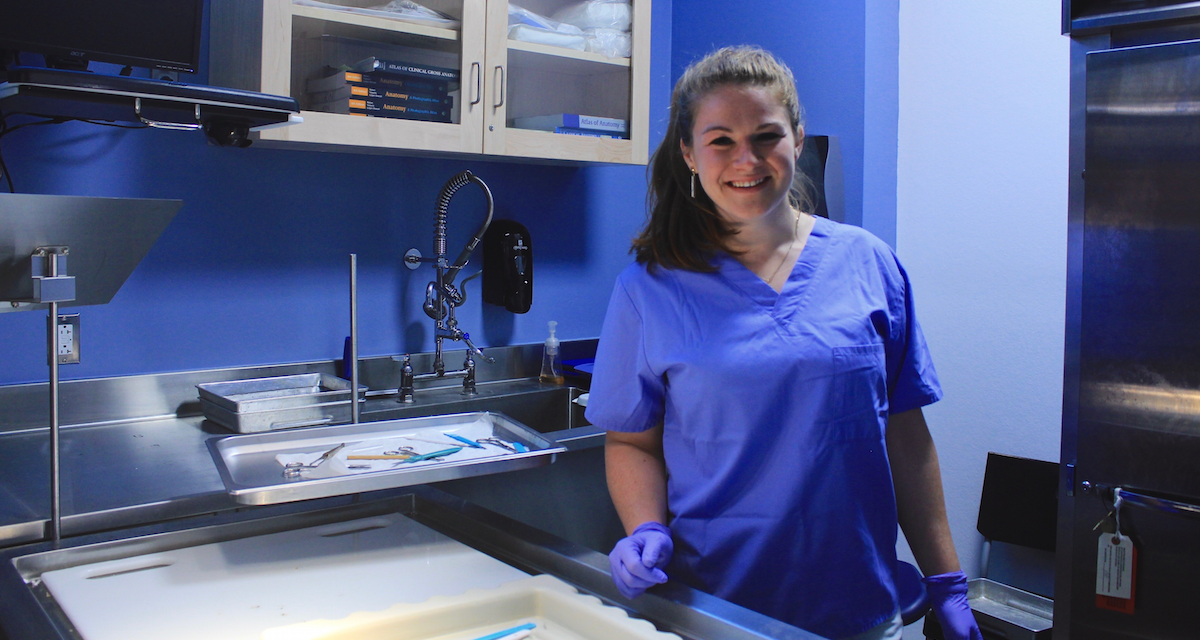From Textbooks to Reality: Reflections from Gordon’s Inaugural Cadaver Lab Cohort
Each lab period this spring, an intrepid group of students left their books and backpacks at the door of Gordon’s new Anatomy and Physiology Lab, swapped their pencils for scalpels, donned lab coats and scrubs, and breathed in the scent of embalming fluid.
Working in the “cadaver lab” on the lower level of Ken Olsen Science Center was a wild, new experience for most of them—but the lab space was carefully designed with students in mind. Kinesiology Department chair Dr. Sean Clark asked a group of seniors for input as the design for Gordon’s new lab was underway, “to make sure students felt cadaver study was an accessible undertaking, not overwhelming.”
With the lab’s first semester now complete, we asked three of the fifteen students from the inaugural cohort to reflect on their initial expectations, challenges, and lessons learned.
Thinking back to the first day, Hannah Dunn ’16 notes that she felt worried that the subject matter might be too advanced. Other students, like Megan Azadian ’16 (pictured above), embraced the fear of the unknown.
Despite their varied approaches, there was one thing in common: their reaction to the first incision. “It was getting over the initial shock of meeting the donor and having the motivation that there was a clear task at hand,” says Patrick Hammer ’16. Hannah and Megan agree. “All the nerves went away,” says Megan. “You were literally stepping into reality from all those textbooks you’ve read.” Hannah says, “For me, it was finally having the confidence in the midst of uneasiness. It was learning to get past the over-thinking and know that you’ve been selected by staff who trust you.”
Their nervousness wore off as time went on. “It becomes more comfortable than you think it’s going to be. It’s not hard when you’re with people who are professionals you can trust,” says Megan. And the design and structure of the lab—a more calming, inviting atmosphere than the typical stark white walls—made it easier for students to find familiarity and confidence while working on the cadavers. “It was less clinical, but everything was kept pristine. The lab provided a professional and comfortable space,” says Patrick.
What really enriched their experience was something that students find in just about every Gordon classroom, studio and lab: the presence of knowledgeable and professional faculty willing to engage and see them succeed. “They made it clear that the goal of the course was not to get as much work done as possible, but to know what work you were doing, exactly,” says Megan. Perhaps most importantly, “Dr. Clark made sure to emphasize the humanness and spirituality of it all, reminding us that the bodies we were studying once housed life.”
Whether it was the delicacy of studying cadavers, or the challenge of learning how to share and delegate tasks, this unique experience tested students not only in their academic knowledge, but also in their ability to work as a team and get the most out of their hands-on experience.
As the semester came to a close, the students expressed gratitude not only for the opportunity to participate in the lab’s first cohort, but for the knowledge and experience gained under the guidance of a professor who was both academically challenging and attentive.
For Gordon’s next cohort of cadaver lab students, Patrick, Megan, and Hannah offer this advice: Be confident and learn to embrace all types of emotion; it’s okay to be nervous, and it’s also okay to be excited; and it doesn’t make you crazy!
Photo and article by Alex Rivera ’16, English language and literature
 The Bell
The Bell